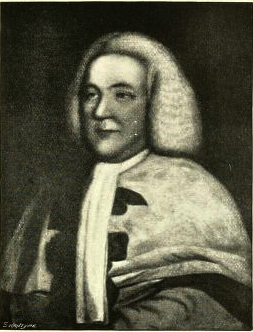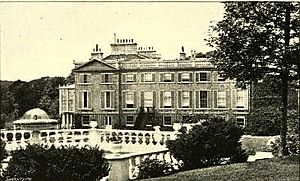James Ferguson, Lord Pitfour facts for kids
Quick facts for kids
James Ferguson, Lord Pitfour
|
|
|---|---|

Lord Pitfour
|
|
| Born | 1700 Pitfour, Aberdeenshire, Scotland
|
| Died | 25 June 1777 (aged 76–77) Gilmerton, Midlothian, Scotland
|
| Nationality | Scottish |
| Occupation | Advocate |
James Ferguson, Lord Pitfour (1700 – 25 June 1777) was a Scottish advocate (a type of lawyer) and the second owner (called Laird) of Pitfour. This was a very large estate in Buchan, Scotland. He had a very successful law practice in Edinburgh. He became the head of the Faculty of Advocates in 1760. Later, in 1764, he became a judge and was known as Lord Pitfour.
Many people thought Lord Pitfour was one of the best lawyers in Scotland. However, by the time he became a judge, he was older and didn't make a big impact in that role. He was known for defending people accused of being involved in the Jacobite risings (a series of rebellions) at trials in Carlisle.
Ferguson inherited the Pitfour estate when his father died. He bought more land and made the estate much bigger. It became so grand that people called it "the Blenheim of the North." He was a strong Episcopalian and had a private church built on his land. He also started a small village and planted many Douglas fir trees near his main house.
Contents
Early Life and Family
James Ferguson was born at Pitfour in 1700. His father, also named James, had just bought the estate. His mother was Ann Stuart.
In 1733, James Ferguson married Anne Murray. She was the sister of Patrick Murray, 5th Lord Elibank and James Murray. James Murray was a British army officer who became the Governor of Quebec in Canada.
James and Anne had three sons and three daughters.
- Their oldest son, James (1736–1820), became a politician.
- Patrick (1744–1780) invented the Ferguson rifle. This was a special type of gun that loaded from the back.
- The youngest son, George (1748–1820), became the Lieutenant Governor of Tobago in 1779.
- Their daughters were Ann, Elizabeth, and Jane.
James Ferguson's father had lost a lot of money in a bad investment called the South Sea Company. But thanks to young James's hard work as a lawyer, the family was able to pay off their debts and keep their lands.
Becoming a Lawyer and Judge
Ferguson studied at Marischal College in Aberdeen from 1711 to 1715. He then studied law at the University of Edinburgh. He finished his education in the Netherlands at Groningen and Utrecht universities.
He became a member of the Faculty of Advocates in Edinburgh in 1722. This group represents lawyers in Scotland. He became the Vice-Dean of the Faculty in 1759. Then, in 1760, he became the Dean (the head) of the Faculty.
In 1764, George III, the King, agreed to make Ferguson a judge. He became a Senator of the College of Justice in June 1764. After this, he was known as "Lord Pitfour."
His law office was in a large, seven-story building in Edinburgh. It was right across from Parliament House, where legal matters were discussed. His law practice was very popular. He could charge twice as much as other lawyers because so many people wanted his help.
Lord Pitfour had many important clients. He helped them with complex legal issues. One case involved a long dispute over land rights. It took three years and many hours of legal work, which made it very profitable for Pitfour.
Defending People in Court
Lord Pitfour was known for supporting the Jacobites. These were people who wanted the Stuart family to be kings of Scotland and England. After the Battle of Culloden, many Jacobite supporters were captured. They were taken to Carlisle Castle for trial in 1746.
Ferguson and another lawyer, Alexander Lockhart, defended these people. The prosecutors were very strict and wanted the accused to be executed. They often assumed anyone wearing tartan (a traditional Scottish cloth pattern) was guilty.
To challenge this, Ferguson and Lockhart had their own servants dress in tartan. They then called them to the stand to prove that even people in tartan could be innocent. This clever trick helped some of the accused to be found not guilty. For example, the Laird of Dunfallandy, who was related to Ferguson, was acquitted.
Lord Pitfour was highly respected by other lawyers. James Boswell, a famous writer and lawyer, said Pitfour was one of Scotland's greatest lawyers. He was part of a group called The Poker Club, which included many important thinkers of the Scottish Enlightenment.
People described Lord Pitfour as good-humored, but a bit clumsy and small. He had a high-pitched voice and poor eyesight. He was also known for being kind and understanding. This sometimes made him different from other judges, who were stricter. He always tried to be fair and find compromises. While this was good for a lawyer, some people thought he was too indecisive as a judge.
Developing the Pitfour Estate
Ferguson inherited the large Pitfour estate when his father died in 1734. As the second Laird, he made the estate even bigger and more impressive. It became one of the grandest estates in Scotland. People called it "the Blenheim of Buchan" or "the Blenheim of the North."
In 1752, Lord Pitfour established the village of Fetterangus. It was just over a mile north of his main house.
In 1766, Lord Pitfour bought even more land for £15,000. This land included St Fergus and Inverugie Castle. It was mostly peat bogs, woods, and undeveloped land. With this new land, Pitfour became the largest estate in the area. It stretched over 30,000 acres (about 120 square kilometers).
Lord Pitfour was an Episcopalian. In 1766, he had a large, plain church built on his estate at Waulkmill. It could hold up to 500 people. He also had a house built in 1756 called Saplinbrae, which was first used as a place for coaches to stop. Later, it became the home for the church minister.
He also planted Douglas fir trees near Saplinbrae and Deer Abbey. The seeds for these trees were sent from Canada by his brother-in-law, General James Murray.
Later Years and Passing

Lord Pitfour's health declined in his later years. He retired from being a judge in 1776. He passed away at Gilmerton on 25 June 1777.
He was buried in a special vault he had built two years earlier in Greyfriars Kirkyard, Edinburgh. This vault was designed to prevent bodysnatchers from disturbing the grave. It has a simple message: "Jacobus Ferguson de Pitfour. Sibi. conjugi, posterisque fecit. A. D. 1775." This means "James Ferguson of Pitfour. For himself, his wife, and his descendants he made this. A.D. 1775."
His wife and two of his sons are also buried in the vault. His eldest son, James, took over the Pitfour estate after his father's death.
Images for kids
-
The tomb of James Ferguson, Lord Pitfour, Greyfriars Kirkyard




